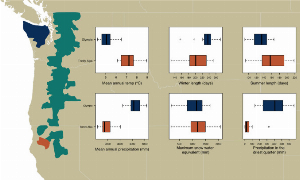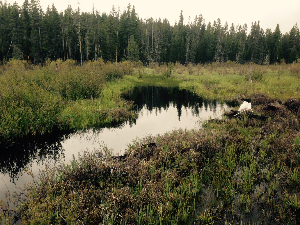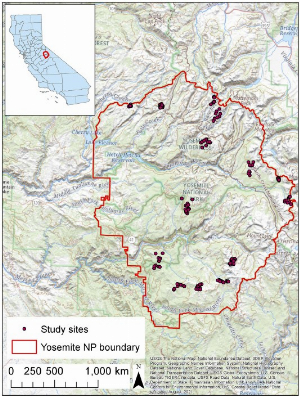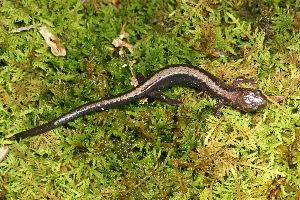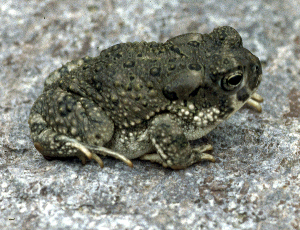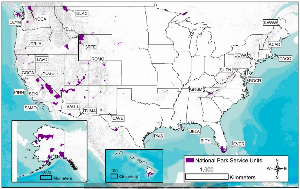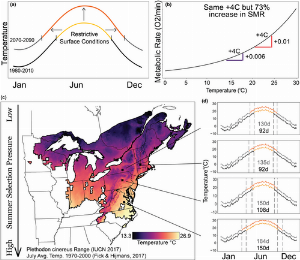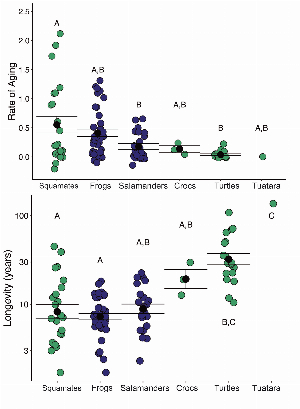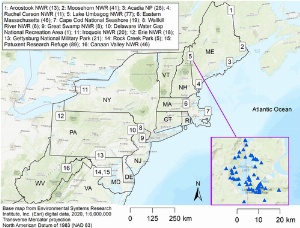Search ARMI Database
Search term(s)
Contribution Number
Search Results
115 record(s) found.
Papers & Reports Contrasting demographic responses under future climate at multiple life stages for two populations of a montane amphibian
Authors: Amanda M Kissel; Wendy J Palen; Michael J Adams; Justin Garwood
Date: 2024-01-03 | Outlet: Climate Change Ecology
For species with complex life histories, climate change can have contrasting effects for different life stages within locally adapted populations and may result in responses counter to general climate change predictions. Using data from two, 14-year demographic studies for a North American montane amphibian, Cascades frog (Rana cascadae), we quantified how aspects of current climate influenced annual survival of larvae and adult stages and modeled the stochastic population growth rate (?s) of each population for current (1980-2006) and future periods (2080s). Climate drivers of survival for the populations were similar for larvae (i.e. decreases in precipitation lead to pond drying and mortality), but diverged for terrestrial stages where decreases in winter length and summer precipitation had opposite effects. By the 2080s, we predict one population will be in sharp decline (?s = 0.90),while the other population will remain nearly stable (?s = 0.99) in the absence of other stressors, such as mortality due to disease. Our case study demonstrates a result counter to many climate envelope predictions in that stage-specific responses to local climate and hydrology result in a higher extinction risk for the more northern population.
Papers & Reports Population Dynamics of the Threatened Oregon Spotted Frog (Rana pretiosa) Before and After Drought Mitigation
Authors: Jennifer C Rowe; Christopher A Pearl; Adam Duarte; Brome McCreary; Michael J Adams
Date: 2023-09-22 | Outlet: The Journal of Wildlife Management
Amphibians are among the most sensitive taxa to climate change, and species inhabiting arid and semiarid landscapes at the extremes of their range are especially vulnerable to drought. The Jack Creek, Oregon, USA, population of Oregon spotted frogs (Rana pretiosa) faces unique challenges because it occupies the highest elevation site in the species' extant range and one that has been transformed by loss of American beavers (Castor canadensis[/]), which historically maintained open water. We evaluated the effects of drought mitigation (addition of excavated ponds) on relationships between local and regional water availability, inactive legacy beaver dams, and Oregon spotted frog population dynamics in the Jack Creek system. We conducted egg mass surveys and capture-mark-recapture sampling at a treatment reach with excavated ponds and 3 reference reaches over 13 years; surveys spanned a period before and after pond excavation at the treatment and 1 primary comparison reference reach. We analyzed data using a combination of robust design capture-mark-recapture estimators and generalized linear mixed models to characterize population dynamics. Adult Oregon spotted frog survival was approximately 19.5% higher at the treatment reach than the primary reference reach during the study period. Annual survival was most strongly associated with late summer vegetation greenness, a proxy for water availability, and males had higher survival than females. Among the 4 study reaches, the treatment reach consistently had higher late summer vegetation greenness, and the hydrology functioned more independently of regional precipitation patterns relative to the reference reaches; however, these dynamics were not linked to pond excavation. Breeding was concentrated in 2 legacy beaver ponds that were deepened by excavation during the study compared to an unexcavated beaver pond, 2 excavated ponds without legacy beaver dams, and 9 reference ponds. These results point to the benefit of enhancing existing beaver structures and indicate that management actions aimed at maintaining surface water for breeding in spring and saturated soils and ponded water for adults in late summer would benefit this unique population of Oregon spotted frogs in the face of drought.
Papers & Reports Sierra Nevada amphibians demonstrate stable occupancy despite precipitation volatility in the early 21st Century
Authors: Brian J Halstead; Patrick M Kleeman; Jonathan P Rose; Gary M Fellers
Date: 2023-02-07 | Outlet: Frontiers in Ecology and Evolution
Climate can have a strong influence on species distributions, and amphibians with different life histories might be affected by annual variability in precipitation in different ways. The Sierra Nevada of California, United States, experienced some of the driest and wettest years on record in the early 21st Century, with variability in annual precipitation predicted to increase with climate change. We examined the relationship between adult occupancy dynamics of three high elevation anurans and site and annual variation in measures of winter severity, summer wetness, and cumulative drought. We further evaluated how these weather conditions affected the probability that each species would reproduce, conditional on their occurrence at a site. We found that although different aspects of weather affected the occupancy dynamics of each species differently, adult occupancy probabilities were generally stable throughout our 15-year study period. The probability of reproduction, although slightly more variable than adult occupancy, was similarly stable throughout the study. Although occurrence of the three species was resilient to recent extremes in precipitation, more detailed demographic study would inform the extent to which amphibian populations will remain resilient to increasing severity, duration, and frequency of drought and flood cycles.
Papers & Reports Abiotic and biotic factors reduce the viability of a high-elevation salamander in its native range
Authors: Evan HC Grant; Graziella V DiRenzo; Adrianne B Brand
Date: 2023-05-20 | Outlet: Journal of Applied Ecology
1. Amphibian populations are undergoing worldwide declines, and high-elevation, range-restricted amphibian species may be particularly vulnerable to environmental stressors. In particular, future climate change may have disproportional impacts to these ecosystems. Evaluating the combined effects of abiotic changes and biotic interactions simultaneously is important for forecasting the range of future outcomes. This information is necessary to aid conservation decision-making.
2. We use field data to estimate population demographic parameters for an exemplary high-elevation amphibian species, the federally endangered Shenandoah salamander (Plethodon shenandoah). These parameters were entered into a Markov projection model which we used to forecast the future population status of the Shenandoah salamander.
3. We found that if the population maintains its current site colonization and persistence rates, it is at risk of extinction that could be exacerbated by both climate and interspecific competition.
4. Synthesis and applications. Managers have a fundamental objective directed by official policy of maintaining the species ‘for the foreseeable future (Grant et al., 2014).’ Our evaluation of multiple hypotheses about population drivers reveals that extinction is projected for this species. Our analysis suggests that considering active management need not depend on resolving the uncertainty.
2. We use field data to estimate population demographic parameters for an exemplary high-elevation amphibian species, the federally endangered Shenandoah salamander (Plethodon shenandoah). These parameters were entered into a Markov projection model which we used to forecast the future population status of the Shenandoah salamander.
3. We found that if the population maintains its current site colonization and persistence rates, it is at risk of extinction that could be exacerbated by both climate and interspecific competition.
4. Synthesis and applications. Managers have a fundamental objective directed by official policy of maintaining the species ‘for the foreseeable future (Grant et al., 2014).’ Our evaluation of multiple hypotheses about population drivers reveals that extinction is projected for this species. Our analysis suggests that considering active management need not depend on resolving the uncertainty.
Papers & Reports Disentangling direct and indirect effects of extreme events on coastal wetland communities
Authors: Courtney L Davis; Susan C Walls; William J Barichivich; Mary E Brown; David AW Miller
Date: 2022-12-16 | Outlet: Journal of Animal Ecology
1. One of the primary ways in which climate change will impact coastal freshwater wetlands is through changes in the frequency, intensity, timing, and distribution of extreme weather events. Disentangling the direct and indirect mechanisms of population- and community-level responses to extreme events is vital to predicting how species composition of coastal wetlands will change under future conditions.
2. We extended static structural equation modeling approaches to incorporate system dynamics in a multi-year multispecies occupancy model to quantify the effects of extreme weather events on a coastal freshwater wetland system.
3. We used data from an 8-year study (2009 to 2016) on St. Marks National Wildlife Refuge in Florida, USA, to quantify species-specific and community-level changes in amphibian and fish occupancy associated with two flooding events in 2012 and 2013. We examine how physical changes to the landscape, including potential changes in salinity and increased wetland connectivity, may have contributed to or exacerbated the effects of these extreme weather events on the biota of isolated coastal wetlands.
4. We provide evidence that the primary effects of flooding on the amphibian community were through indirect mechanisms via changes in the composition of the sympatric fish community that may have had lethal (i.e., through direct predation) or non-lethal (i.e., through direct or indirect competitive interactions) effects. In addition, we shown that amphibian species differed in their sensitivity to direct flooding effects and indirect changes in the fish community and wetland specific conductance, which led to variable responses across the community. These effects led to the overall decline in amphibian species richness from 2009 to 2016, suggesting that wetland-breeding amphibian communities on St. Marks may not be resilient to predicted changes in coastal disturbance regimes as a result of climate change.
5. Understanding both direct and indirect effects, as well as species interactions, is important for predicting the effects of a changing climate on individual species, communities, and ecosystems.
2. We extended static structural equation modeling approaches to incorporate system dynamics in a multi-year multispecies occupancy model to quantify the effects of extreme weather events on a coastal freshwater wetland system.
3. We used data from an 8-year study (2009 to 2016) on St. Marks National Wildlife Refuge in Florida, USA, to quantify species-specific and community-level changes in amphibian and fish occupancy associated with two flooding events in 2012 and 2013. We examine how physical changes to the landscape, including potential changes in salinity and increased wetland connectivity, may have contributed to or exacerbated the effects of these extreme weather events on the biota of isolated coastal wetlands.
4. We provide evidence that the primary effects of flooding on the amphibian community were through indirect mechanisms via changes in the composition of the sympatric fish community that may have had lethal (i.e., through direct predation) or non-lethal (i.e., through direct or indirect competitive interactions) effects. In addition, we shown that amphibian species differed in their sensitivity to direct flooding effects and indirect changes in the fish community and wetland specific conductance, which led to variable responses across the community. These effects led to the overall decline in amphibian species richness from 2009 to 2016, suggesting that wetland-breeding amphibian communities on St. Marks may not be resilient to predicted changes in coastal disturbance regimes as a result of climate change.
5. Understanding both direct and indirect effects, as well as species interactions, is important for predicting the effects of a changing climate on individual species, communities, and ecosystems.
Papers & Reports Compensatory recruitment unlikely in high elevation amphibian populations challenged with disease
Authors: Bennett Hardy; Erin Muths; Brad A Lambert; S C Schneider; W C Funk; Larissa L Bailey
Date: 2022-07-12 | Outlet: Journal of Applied Ecology
1. Understanding the causes of population variation in host response to disease, and the mechanisms of persistence, can serve as vital information for species conservation. One such mechanism of population persistence that has gained support is the demographic process of compensatory recruitment. Host populations may persist by increasing recruitment to compensate for reduced survival due to infection, thus limiting the negative effects of the disease on population trajectories. However, high elevation populations are inherently vulnerable to stochastic processes and may be limited in their ability to exhibit compensatory recruitment relative to lower elevation populations.
2. We use long-term mark-recapture data from five populations of boreal toads (Anaxyrus boreas boreas ), across an elevational gradient in Colorado, before and after pathogen arrival to assess whether populations can persist with Batrachochytrium dendrobatidis (Bd) via compensatory recruitment.
3. Prior to pathogen arrival, we found a life history tradeoff between survival and recruitment across elevations, where high elevation toads have high survival but lower recruitment and vice versa at lower elevations.
4. Pathogen arrival had a strong negative effect on apparent annual survival and recruitment leading to negative population growth rates and dramatically reduced host abundances. The data did not support the occurrence of compensatory recruitment.
5. Synthesis and applications. Our unique dataset indicates that demographic responses to pathogens may be environmentally (i.e., elevationally) context-dependent and highlights the value of long-term monitoring. We recommend that practitioners verify that potential persistence mechanisms occur across multiple populations and relevant environmental gradients to counter any assumptions of the mechanism existing species-wide. Quantifying variation in population responses to disease will aid in understanding the bounds of such persistence mechanisms and identify particularly vulnerable populations where mechanisms are non-existent.
2. We use long-term mark-recapture data from five populations of boreal toads (Anaxyrus boreas boreas ), across an elevational gradient in Colorado, before and after pathogen arrival to assess whether populations can persist with Batrachochytrium dendrobatidis (Bd) via compensatory recruitment.
3. Prior to pathogen arrival, we found a life history tradeoff between survival and recruitment across elevations, where high elevation toads have high survival but lower recruitment and vice versa at lower elevations.
4. Pathogen arrival had a strong negative effect on apparent annual survival and recruitment leading to negative population growth rates and dramatically reduced host abundances. The data did not support the occurrence of compensatory recruitment.
5. Synthesis and applications. Our unique dataset indicates that demographic responses to pathogens may be environmentally (i.e., elevationally) context-dependent and highlights the value of long-term monitoring. We recommend that practitioners verify that potential persistence mechanisms occur across multiple populations and relevant environmental gradients to counter any assumptions of the mechanism existing species-wide. Quantifying variation in population responses to disease will aid in understanding the bounds of such persistence mechanisms and identify particularly vulnerable populations where mechanisms are non-existent.
Papers & Reports Winter severity affects occupancy of spring- and summer-breeding anurans across the eastern United States
Authors: Sara R weiskopf; Alexey N Shiklomanov; Laura Thompson; Sarah Wheedleton; Evan HC Grant
Date: 2022-08-09 | Outlet: Diversity and Distributions
Climate change is an increasingly important driver of biodiversity loss. The ectothermic nature of amphibians may make them particularly sensitive to changes in normal temperature and precipitation regimes, exacerbating global declines from other threats. In this study, we used large-scale citizen science data from the eastern half of the United States to assess how variation in winter severity influenced occupancy dynamics of 11 anuran species. We found that most species had increased occupancy in years with greater than average snow cover and warmer than average mean winter temperatures. Surprisingly, we found that climatic conditions in winter affected occupancy dynamics of both spring and summer breeding species, indicating that changing winter conditions may have consequences for anuran species with varying life history characteristics. As the climate continues to change, expected reductions in snowpack may act as an additional stressor on already declining anuran populations, while milder winters may improve overwinter survival for some species.
Papers & Reports Cryptic declines of small, cold-water specialists highlight potential vulnerabilities of headwater streams as climate refugia
Authors: Blake R Hossack; M LeMoine; Emily B Oja; Lisa A Eby
Date: 2023 | Outlet: Biological Conservation
Increasing temperatures and climate-driven disturbances like wildfire are a growing threat to many species,
including cold-water specialists. Montane areas and cold streams are often considered climate refugia that buffer
communities against change. However, climate refugia are often species-specific, and despite growing awareness
that life histories and habitat requirements shape responses to change, small or non-game species are often
under-represented in monitoring and planning programs. A recent study in Montana, USA, revealed much larger
warming-related declines in occupancy for small, non-game slimy sculpin (Cottus cognatus) between 1993 and
1995 and 2011–2013 than for two socially valued salmonid fishes that shape regional conservation efforts. To
broaden insight into climate change vulnerabilities of headwater stream communities, we analyzed data for
Rocky Mountain tailed frogs (Ascaphus montanus) that were collected during those same electrofishing surveys
for fishes from 241 stream reaches. Tailed frogs occupy small, cold streams and have several life-history traits
that make them sensitive to environmental change. We used a Bayesian framework to estimate occupancy,
colonization, and extinction dynamics relative to forest canopy, estimated stream temperature, and wildfire
effects. Tailed frog occupancy decreased by 19 % from 1993 to 1995 to 2011–2013. Changes in occupancy were
linked with increased extinction and reduced colonization where there were fire-driven reductions in canopy
cover, and reduced colonization of stream reaches that warmed on average 0.8 ?C during the study. Our results
highlight extensive extirpations for oft-overlooked species and emphasize the importance of including species
with diverse habitat requirements and life histories in conservation planning.
including cold-water specialists. Montane areas and cold streams are often considered climate refugia that buffer
communities against change. However, climate refugia are often species-specific, and despite growing awareness
that life histories and habitat requirements shape responses to change, small or non-game species are often
under-represented in monitoring and planning programs. A recent study in Montana, USA, revealed much larger
warming-related declines in occupancy for small, non-game slimy sculpin (Cottus cognatus) between 1993 and
1995 and 2011–2013 than for two socially valued salmonid fishes that shape regional conservation efforts. To
broaden insight into climate change vulnerabilities of headwater stream communities, we analyzed data for
Rocky Mountain tailed frogs (Ascaphus montanus) that were collected during those same electrofishing surveys
for fishes from 241 stream reaches. Tailed frogs occupy small, cold streams and have several life-history traits
that make them sensitive to environmental change. We used a Bayesian framework to estimate occupancy,
colonization, and extinction dynamics relative to forest canopy, estimated stream temperature, and wildfire
effects. Tailed frog occupancy decreased by 19 % from 1993 to 1995 to 2011–2013. Changes in occupancy were
linked with increased extinction and reduced colonization where there were fire-driven reductions in canopy
cover, and reduced colonization of stream reaches that warmed on average 0.8 ?C during the study. Our results
highlight extensive extirpations for oft-overlooked species and emphasize the importance of including species
with diverse habitat requirements and life histories in conservation planning.
Papers & Reports Future changes in habitat availability for two specialist snake species in the imperiled rocklands of South Florida, U.S.A
Authors: Suresh C. Subedi; Susan C Walls; William J Barichivich; Ryan Boyles; Michael S. Ross; J Aa Hogan; John A Tupy
Date: 2022-08-30 | Outlet: Conservation Science and Practice
Rockland habitat in South Florida, USA, is a threatened ecosystem that has been lost, fragmented, or degraded because of urbanization or other anthropogenic disturbance. Furthermore, low-lying islands and coastal areas are experiencing sea-level rise (SLR) and an increased frequency and intensity of tidal flooding, putting rockland habitats there at increasing risk of ecological change. We evaluated changes in the extent of rockland habitat under various scenarios of future SLR, tidal flooding, and human development for two endemic state-listed threatened species of snakes, the Rim Rock Crowned Snake (Tantilla oolitica) and the Key Ring-necked Snake (Diadophis punctatus acricus). Both snakes are restricted to South Florida. We used recent and historical species’ records to determine each species’ habitat range. We then estimated the extent of future habitat loss due to SLR and continued human development, as well as degradation of the remaining habitat. We also asked whether the future potential drivers of habitat loss and degradation differ between the two species and across their habitat ranges. We predicted that saltwater intrusion could negatively affect rocklands by 2050, resulting in degradation of 80% of the existing habitat because of an anticipated 42 cm of SLR. Moreover, short-term stochastic events such as storm surge and high tides will increasingly saturate the root zone of rockland vegetation before complete inundation. Most of the rockland habitat used by these two species of snakes will be inundated by 2080. Sea level rise will likely change current rocklands into more halophytic habitat (mangrove or salt marsh wetland) within 50 to 60 years. As much as 47% of rockland habitat will be lost due to human development by 2030. Therefore, immediate mitigation actions may be needed to conserve specialist species within rockland habitat that is threatened by human activities and climate change.
Papers & Reports Using physiological conditions to assess current and future habitat use of a Subarctic frog
Authors: Thomas P Hastings; Blake R Hossack; L Fishback; J M Davenport
Date: 2022 | Outlet: Integrative Zoology
Species with especially close dependence on the environment to meet physiological requirements, such as ectotherms, are highly susceptible to the impacts of climate change. Climate change is occurring rapidly in the Subarctic and Arctic, but there is limited knowledge on ectotherm physiology in these landscapes. We investigated how environmental conditions and habitat characteristics influence the physiological conditions and habitat use of wood frogs (Rana sylvatica, LeConte 1825) in a Subarctic landscape near Churchill, Manitoba (Canada). We used plaster models to estimate water loss rates and surface body temperatures among different habitat types and at specific locations used by radio-tracked frogs. Water loss (R^2 = 0.67) and surface temperature (R^2 = 0.80) of plaster models was similar to that of live frogs. Model-based water loss rates were greater in tundra habitat than in boreal forest and ecotone habitat. Habitat use of wood frogs was strongly tied with available surface moisture and decreased water loss rates that were observed with plaster models. Environmental conditions, such as wind speed and ground temperature, explained 58% and 91% of the variation in water balance and temperature of plaster models. Maintaining physiological conditions may be challenging for semi-aquatic ectotherms in environments vulnerable to future climate change. The ability to predict physiological conditions based on environmental conditions, as demonstrated in our study, can help understand how wildlife will respond to climatic changes.
Papers & Reports Range-wide Persistence of the Endangered Arroyo Toad (Anaxyrus californicus) for 20+ Years Following a Prolonged Drought
Authors: C J Hitchcock; Elizabeth A Gallegos; Adam R Backlin; Russell Barabe; Peter H Bloom; Kimberly Boss; Cheryl S Brehme; Christopher W Brown; D R Clark; Elizabeth R Clark; Kevin Cooper; Julie Donnell; Edward L Ervin; Peter Famolaro; Kim M Guilliam; Jacquelyn J Hancock; Nicholas Hess; Steven Howard; Valerie Hubbartt; Patrick Lieske; Robert E Lovich; Tritia Matsuda; Katherin Meyer-Wilkins; Kamarul Muri; Barry Nerhus; J A Nordland; Brock Ortega; Robert H Packard; Ruben Ramirez; Sam C Stewart; S Sweet; M L Warburton; Jeffrey Wells; Ryan Winkleman; Kirsten Winter; Brian Zitt; Robert N Fisher
Date: 2022-03 | Outlet: Ecology and Evolution 12:e8796
Prolonged drought due to climate change has negatively impacted amphibians in southern California, U.S.A. Due to the severity and length of the current drought,
agencies and researchers had growing concern for the persistence of the arroyo toad (Anaxyrus californicus), an endangered endemic amphibian in this region. Range-wide surveys for this species had not been conducted for at least 20 years. In 2017–2020, we conducted collaborative surveys for arroyo toads at historical locations. We surveyed 88 of the 115 total sites having historical records and confirmed that the arroyo toad is currently extant in at least 61 of 88 sites and 20 of 25 historically occupied watersheds. We did not detect toads at almost a third of the surveyed sites but did detect toads at 18 of 19 specific sites delineated in the 1999 Recovery Plan to meet one of four downlisting criteria. Arroyo toads are estimated to live 7–8 years, making populations susceptible to prolonged drought. Drought is estimated to increase in frequency and duration with climate change. Mitigation strategies for drought impacts, invasive aquatic species, altered flow regimes, and other anthropogenic effects could be the most beneficial strategies for toad conservation and may also provide simultaneous benefits to several other native species that share the same habitat.
agencies and researchers had growing concern for the persistence of the arroyo toad (Anaxyrus californicus), an endangered endemic amphibian in this region. Range-wide surveys for this species had not been conducted for at least 20 years. In 2017–2020, we conducted collaborative surveys for arroyo toads at historical locations. We surveyed 88 of the 115 total sites having historical records and confirmed that the arroyo toad is currently extant in at least 61 of 88 sites and 20 of 25 historically occupied watersheds. We did not detect toads at almost a third of the surveyed sites but did detect toads at 18 of 19 specific sites delineated in the 1999 Recovery Plan to meet one of four downlisting criteria. Arroyo toads are estimated to live 7–8 years, making populations susceptible to prolonged drought. Drought is estimated to increase in frequency and duration with climate change. Mitigation strategies for drought impacts, invasive aquatic species, altered flow regimes, and other anthropogenic effects could be the most beneficial strategies for toad conservation and may also provide simultaneous benefits to several other native species that share the same habitat.
Papers & Reports Looking ahead, guided by the past: The role of U.S. national parks in amphibian research and conservation
Authors: Brian J Halstead; Andrew M Ray; Erin Muths; Evan HC Grant; Rob L Grasso; Michael J Adams; Katy S Delaney; Jane Carlson; Blake R Hossack
Date: 2022-03 | Outlet: Ecological Indicators
Protected areas like national parks are essential elements of conservation because they limit human influence on the landscape, which protects biodiversity and ecosystem function. The role of national parks in conservation, however, often goes far beyond limiting human influence. The U.S. National Park Service and its system of land units contribute substantively to conservation by providing protected lands where researchers can document trends in species distributions and abundances, examine characteristics important for generating these trends, and identify and implement conservation strategies to preserve biodiversity. We reviewed the contribution of U.S. national parks to amphibian research and conservation and highlight important challenges and findings in several key areas. First, U.S. national parks were instrumental in providing strong support that amphibian declines were real and unlikely to be simply a consequence of habitat loss. Second, research in U.S. national parks provided evidence against certain hypothesized causes of decline, like UV-B radiation, and evidence for others, such as introduced species and disease. However, describing declines and identifying causes contributes to conservation only if it leads to management; importantly, U.S. national parks have implemented many conservation strategies and evaluated their effectiveness in recovering robust amphibian populations. Among these, removal of invasive species, especially fishes; conservation translocations; and habitat creation and enhancement stand out as examples of successful conservation strategies with broad applicability. Successful management for amphibians is additionally complicated by competing mandates and stakeholder interests; for example, past emphasis on increasing visitor enjoyment by introducing fish to formerly fishless lakes had devastating consequences for many amphibians. Other potential conflicts with amphibian conservation include increasing development, increased risk of introductions of disease and exotic species with increased visitation, and road mortality. Decision science and leveraging partnerships have proven to be key components of effective conservation under conflicting mandates in national parks. As resource managers grapple with large-scale drivers that are outside local control, public-private partnerships and adaptive strategies are increasing in importance. U.S. national parks have played an important role in many aspects of identifying and ameliorating the amphibian decline crisis and will continue to be essential for the conservation of amphibians in the future.
Papers & Reports Identifying factors linked with persistence of reintroduced populations: lessons learned from 25 years of amphibian translocations
Authors: Blake R Hossack
Date: 2022 | Outlet: Global Ecology and Conservation
Most translocation efforts are unsuccessful, often for unknown reasons. We assessed factors linked with population persistence for 25 years of translocations of the federally threatened Chiricahua Leopard Frog. Local features were paramount, including habitat, predators, and restoration history. Timing and life stages stocked affected persistence, but rearing environment did not. Two or more translocations produced an approximate 4-yr increase in predicted population persistence.
Papers & Reports Geographic variation and thermal plasticity shape salamander metabolic rates under current and future climates
Authors: David J Muñoz; David AW Miller; R Schilder; Evan HC Grant
Date: 2022-01-15 | Outlet: Ecology and Evolution
Predicted changes in global temperature are expected to increase extinction risk for ectotherms, primarily through increased metabolic rates. Higher metabolic rates generate increased maintenance energy costs which are a major component of energy budgets. Organisms often employ plastic or evolutionary (e.g. local adaptation) mechanisms to optimize metabolic rate with respect to their environment. We examined relationships between temperature and standard metabolic rate across four populations of a widespread amphibian species to determine if populations vary in metabolic response and if their metabolic rates are plastic to seasonal thermal cues. Populations from warmer climates lowered metabolic rates when acclimating to summer temperatures as compared to spring temperatures. This may act as an energy saving mechanism during the warmest time of the year. No such plasticity was evident in populations from cooler climates. Both juvenile and adult salamanders exhibited metabolic plasticity. Although some populations responded to historic climate thermal cues, no populations showed plastic metabolic rate responses to future climate temperatures, indicating there are constraints on plastic responses. We postulate that impacts of warming will likely impact the energy budgets of salamanders, potentially affecting key demographic rates, such as individual growth and investment in reproduction.
Papers & Reports Diverse aging rates in ectotherms provide insights for the evolution of aging and longevity
Authors: Beth A Reinke; Hugo Cayuela; Fredric J Janzen; Jean-Francois Lemaitre; Jean-Michel Gaillard; Michelle A Lawing; John B Iverson; Ditte G Christiansen; Iñigo Martinez-Solano; Gregorio Sánchez-Montes; Jorge Gutiérrez-Rodríguez; Francis L Rose; Nicola Nelson; Susan Keall; Alain J Crivelli; Theodoros Nazirides; Annegret Grimm-Seyfarth; Klaus Henle; Emiliano Mori; Gaëtan Guiller; Rebecca Homan; Anthony Olivier; Erin Muths; Blake R Hossack; Xavier Bonnet; David S Pilliod; Marieke Lettink; Tony Whitaker; Benedikt R Schmidt; Michael G Gardner; Marc Cheylan; Francoise Poitevin; Ana Golubovi?; Ljiljana Tomovic; Dragan Arsovski; Richard A Griffiths; Jan W Arntzen; Jean-Pierre Baron; Jean-Francois Le Galliard; Thomas Tully; Luca Luiselli; Massimo Capula; Lorenzo Rugiero; Rebecca M McCaffery; Lisa A Eby; Venetia Briggs-Gonzalez; Frank J Mazzotti; David Pearson; Brad A Lambert; D M Green; Nathalie Jreidini; Claudio Angelini; Graham Pyke; Jean-Marc Thirion; Pierre Joly; Jean-Paul Lena; Tony Tucker; Col Limpus; Pauline Priol; Aurélien Besnard; Pauline Bernard; Kristin Stanford; Richard King; Justin Garwood; Jaime Bosch; Franco Souza; Jaime Bertoluci; Shirley Famelli; Kurt Grossenbacher; Omar Lenzi; Kathleen Matthews; Sylvain Boitaud; Deanna H Olson; Tim Jessop; Graeme Gillespie; Jean Clobert; Murielle Richard; Andrés Valenzuela-Sánchez; Gary M Fellers; Patrick M Kleeman; Brian J Halstead; Evan HC Grant; Phillip G Byrne; Thierry Frétey; Bernard Le Garff; Pauline Levionnois; John C Maerz; Julian Pichenot; Kurtulus Olgun; Nazan Uzum; Aziz Avci; Claude Miaud; Johan Elmberg; Gregory P Brown; Richard Shine; Nathan F Bendik; Lisa O'Donnell; Courtney L Davis; Michael J Lannoo; Rochelle M Stiles; Robert M Cox; Aaron M Reedy; Daniel A Warner; Eric Bonnaire; Kristine Grayson; Roberto Ramos-Targarona; Eyup Baskale; David J Muñoz; John Measey; Andre de Villiers; Will Selman; Anne M Bronikowski; David AW Miller
Date: 2022-06-23 | Outlet: Science
Comparative studies of mortality in the wild are necessary to understand the evolution of aging, yet ectothermic tetrapods are under-represented in this comparative landscape despite their suitability for testing evolutionary hypotheses. We provide the first comprehensive study of aging rates and longevity across tetrapod ectotherms in the wild, utilizing data from 107 populations (77 species) of reptiles and amphibians. We test hypotheses of how thermoregulatory mode, temperature, protective phenotypes, and pace of life contribute to aging. Controlling for phylogeny and body size, ectotherms displayed a higher diversity of aging rates than endotherms, and included many groups with negligible aging. Furthermore, protective phenotypes and life-history tactics further explained macroevolutionary patterns of aging. By including ectothermic tetrapods, our comparative analyses enhance our understanding of aging evolution.
Papers & Reports Mapping climate-resistant vernal pools: hydrologic refugia for amphibian reproduction under droughts and climate change
Authors: Evan HC Grant; Jennifer M Cartwright; TL Morelli
Date: 2021-09-02
Vernal pools of the northeastern United States provide important breeding habitat for amphibians but may be sensitive to droughts and climate change. These seasonal wetlands typically fill by early spring and dry by mid-to-late summer. Because climate change may produce earlier and stronger growing-season evapotranspiration combined with increasing droughts and shifts in precipitation timing, management concerns include the possibility that some pools will increasingly become dry earlier in the year, potentially interfering with amphibian life-cycle completion. In this context, a subset of pools that continue to provide wetland habitat later into the year under relatively dry conditions might function as ecohydrologic refugia, potentially supporting species persistence even as summer conditions become warmer and droughts more frequent. We used approximately 3,000 field observations of inundation from 450 pools to train machine-learning models that predict the likelihood of pool inundation based on pool size, day of the year, climate conditions, short-term weather patterns, and soil, geologic, and landcover attributes. Models were then used to generate predictions of pool wetness across five seasonal time points, three short-term weather scenarios, and four sets of downscaled climate projections. Model outputs are available through a user-friendly website allowing users to choose the inundation thresholds, time points, weather scenarios, and future climate projections most relevant to their management needs. Together with long-term monitoring of individual pools at the site scale, this regional-scale study can support amphibian conservation by helping to identify which pools may be most likely to function as ecohydrologic refugia from droughts and climate change.
Papers & Reports Western pond turtles in the Mojave Desert? A review of their past, present, and possible future
Authors: J Lovich; G . Jefferson; Robert Reynolds; P Scott; H B Shaffer; Shellie Puffer; Sarah Greely; Kristy Cummings; Robert N Fisher; Katherin Meyer-Wilkins; Doug Gomez; Morgan Ford; Christopher D. Otahal
Date: 2021-05-25 | Outlet: Vertebrate Zoology 71:317-334.
The western pond turtle (WPT) was formerly considered a single species (Actinemys or Emys marmorata[I/}) that ranged from southern British Columbia, Canada to Baja California, México. More recently it was divided into a northern and a southern species. WPTs are found primarily in streams that drain into the Pacific Ocean, although scattered populations exist in endorheic drainages of the Great Basin and Mojave deserts. Populations in the Mojave Desert were long thought to be restricted to the Mojave River, but recently another population was documented in Piute Ponds, a terminal wetland complex associated with Amargosa Creek on Edwards Air Force Base. WPT fossils in the Mojave Desert are known from the Miocene to the Pleistocene. Recently, Pleistocene fossils have been found as far into the desert as Salt Springs, just south of Death Valley. The oldest fossil records suggest that WPTs were present in wetlands and drainages of the geological feature known as the Mojave block prior to the uplift of the Sierra Nevada Range about 8 Ma and prior to the ~ 3 Ma uplift of the Transverse Ranges. Archaeological records document use of turtles by Native Americans for food and cultural purposes 1,000 or more years ago at the Cronese Lakes on the lower Mojave River and Oro Grande on the upper river. The first modern publication documenting their presence in the Mojave River was 1861. Museum specimens were collected as early as 1937. These fossil and early literature records support the indigenous status of WPTs to the Mojave River. However, mtDNA-based genetic evidence shows that Mojave River turtles share an identical haplotype with turtles on the California coast. Limited nuclear data show some minor differences. Overdraft of the Mojave River for municipal and agricultural uses, urban development, and saltcedar expansion are threats to the continued survival of WPTs in the Mojave River.
Papers & Reports Thermal conditions predict intraspecific variation in senescence rate in frogs and toads
Authors: Hugo Cayuela; Rebecca M McCaffery; Thierry Frétey; Benedikt R Schmidt; Kurt Grossenbacher; Omar Lenzi; Blake R Hossack; Brad A Lambert; Johan Elmberg; J Merilä; J Gippet; David S Pilliod; Erin Muths
Date: 2021-11 | Outlet: PNAS
Variation in temperature is known to influence mortality patterns in ectotherms. Even though a few experimental studies on model organisms have reported a positive relationship between temperature and actuarial senescence (i.e., the increase in mortality risk with age), how variation in climate influences senescence rate across the range of a species is still poorly understood in free-ranging animals. We filled this knowledge gap by investigating the relationships linking senescence rate, adult lifespan, and climatic conditions using long-term, capture-recapture data from multiple amphibian populations. We considered two pairs of related anuran species from the Ranidae (Rana luteiventris, Rana temporaria) and Bufonidae (Anaxyrus boreas, Bufo bufo) families, which diverged more than 100 mya and are broadly distributed in North America and Europe. Senescence rates were positively associated with mean annual temperature in all species. In addition, lifespan was negatively correlated with mean annual temperature in all species except A. boreas. In both R. luteiventris and A. boreas, mean annual precipitation and human environmental footprint both had negligible effects on senescence rates or lifespans. Overall, our findings demonstrate the critical influence of thermal conditions on mortality patterns across anuran species from temperate regions. In the current context of further global temperature increase predicted by IPCC scenarios, a widespread acceleration of aging in amphibians is expected to occur in the decades to come, which might threaten even more seriously the viability of populations and exacerbate global decline.
Papers & Reports The Coyote Mountains’ Desert Snail (Sonorelix harperi carrizoensis), a Lazarus Species with the First Documentation of Live Individuals
Authors: Robert N Fisher; S R Fisher
Date: 2020-08 | Outlet: Bulletin Southern California Academy of Sciences 119:49-54.
The Coyote Mountain desert snail (Sonorelix harperi carrizoensis) was described in 1937 from 30 dry shells collected the previous year. We reviewed the literature and museum records and found two additional shell collections for this subspecies from the type locality one from 1958, and one from an adjacent mountain range in 1938. There is no evidence previously of any live snails being collected from the Coyote Mountains, Imperial County, California. All shell collections of S. harperi carrizoensis have the same locality data as the type series, which is Painted Gorge, Coyote Mountains except for one recorded collection of shells from the Vallecito Mountains from 1938. Using geological maps and other data sources, a potential mesic habitat was identified in the Coyote Mountains. During recent field work for salamanders at this location we detected two live specimens of S. harperi carrizoensis approximately 2 km north of its type location. This new data confirms this subspecies is still extant and has occurred at least at two sites historically in these mountains. Despite the presence of mesic habitats (i.e., mosses, liverworts and ferns) at the type locality, we found no evidence of S. harperi carrizoensis or salamanders.
Papers & Reports Baseline Conditions and Projected Future Hydro-Climatic Change in National Parks in the Conterminous United States
Authors: William A Battaglin
Date: 2020-06-15 | Outlet: Water 2020, 12(6), 1704; https://doi.org/10.3390/w12061704
Abstract: The National Park Service (NPS) manages hundreds of parks in the United States, and many contain important aquatic ecosystems and/or threatened and endangered aquatic species vulnerable to hydro-climatic change. More effective management of park resources under future hydro-climatic uncertainty requires information on both baseline conditions and the range of projected future conditions. A monthly water balance model was used to assess baseline (1981–1999) conditions and a range of projected future hydro-climatic conditions in 374 NPS parks. General circulation model outputs representing 214 future climate simulations were used to drive the model. Projected future changes in air temperature (T), precipitation (p), and runoff (R) are expressed as departures from historical baselines. Climate simulations indicate increasing T by 2030 for all parks with 50th percentile simulations projecting increases of https://1.67 °C or more in 50% of parks. Departures in 2030 p indicate a mix of mostly increases and some decreases, with 50th percentile simulations projecting increases in p in more than 70% of parks. Departures in R for 2030 are mostly decreases, with the 50th percentile simulations projecting decreases in R in more than 50% of parks in all seasons except winter. Hence, in many NPS parks, R is projected to decrease even when p is projected to increase because of increasing T in all parks. Projected changes in future hydro-climatic conditions can also be assessed for individual parks, and Rocky Mountain National Park and Congaree National Park are used as examples.

